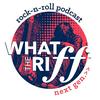403 episodes

1997 - January: 311 “311”
29/12/2025 | 27 mins.
Lynch riffs on the third studio album from 311, eponymously entitled 311 from January 1997 (All Mixed Up / Misdirected Hostility / Don't Stay Home / Down). STAFF PICKS: The Freshmen by The Verve Pipe — Rob. The Distance by Cake — Wayne. Van Halen by Nerf Herder — Bruce. NOVELTY TRACK: Enter Sandman by Pat Boone.

2000 - December: Kiss “Kiss Symphony:Alive IV”
22/12/2025 | 38 mins.
Wayne riffs on the fourth album in the Alive series by Kiss, Kiss Symphony: Alive IV, from December 2000 (Lick It Up / Calling Dr. Love / Love Gun / Detroit Rock City). STAFF PICKS: “Are You There” by Oleander — Lynch. “If You're Gone” by Matchbox Twenty — Rob. "Hanging By a Moment” by Lifehouse — Bruce. "Hemorrhage (In My Hands) - Fuel - Julie Doran. ENTERTAINMENT TRACK: "He Carves the Roast Beast" (from the motion picture "How the Grinch Stole Christmas").

1995 - June: Alanis Morisette “Jagged Little Pill”
15/12/2025 | 39 mins.
Guest Host Julie Doran riffs on the third studio album by Alanis Morissette, Jagged Little Pill from June 1995 (You Oughta Know / Ironic / Hand in My Pocket / Head Over Feet). STAFF PICKS: “Lightning Crashes” by Live — Rob. “Tomorrow” by Silverchair — Lynch. “Mockingbird Girl” by Magnificent Bastards - Wayne. “No More ‘I Love You's’” by Annie Lennox — Bruce. ENTERTAINMENT TRACK: “Hold Me, Thrill Me, Kiss Me, Kill Me” by U2 (from the motion picture “Batman Forever”).

Christmas Songs that Rock VIII
08/12/2025 | 47 mins.
MERRY CHRISTMAS!! What The Riff?!? hopes you enjoy our EIGHTH ANNUAL Christmas Rabbit Hole Episode in which we riff on the Christmas standards, classics, covers, and originals that make Christmas Rock! This year, we’re covering: Little Drummer Boy - Joan Jett & The Blackhearts. Jingle Bell Rock - Daryl Hall & John Oates. I Believe In Stanta Claus - Kenny Rogers & Dolly Parton. Please Daddy (Don't Get Drunk this Christmas) - John Denver. Last Christmas - Wham! White Christmas - Chicago. O Holy Night - Michael McDonald. Christmas at Ground Zero - "Wierd Al" Yankovic. Grown Up Christmas List - Amy Grant. Please Come Home for Christmas -Cheap Trick. Hard Candy Christmas - Dolly Parton. Redneck Christmas - Ray Stevens. All I Want for Christmas is You - Mariah Carey. And we close out with a very special Christmas song by Lynch’s band, “Cherubic Trash Panda” - exclusively from What the Riff?!? records!

2001 - December: No Doubt “Rock Steady”
01/12/2025 | 29 mins.
Rob riffs on the fifth studio album by No Doubt, “Rock Steady,” from December 2001 (Intro / Hella Good / Hey Baby / Platinum Blonde Life / Making Out). STAFF PICKS: “Blurry” by Puddle of Mudd — Lynch. “In Too Deep” by Sum 41 — Bruce. ENTERTAINMENT TRACK: “A Kaleidoscope of Mathematics” (from the motion picture "A Beautiful Mind").
More History podcasts
Trending History podcasts
About What the Riff Next Gen
Listen to What the Riff Next Gen, The Ancients and many other podcasts from around the world with the radio.net app

Get the free radio.net app
- Stations and podcasts to bookmark
- Stream via Wi-Fi or Bluetooth
- Supports Carplay & Android Auto
- Many other app features
Get the free radio.net app
- Stations and podcasts to bookmark
- Stream via Wi-Fi or Bluetooth
- Supports Carplay & Android Auto
- Many other app features


What the Riff Next Gen
download the app,
start listening.





































